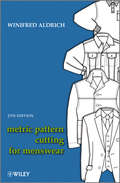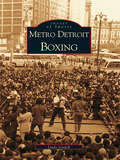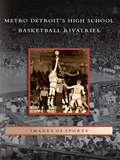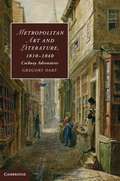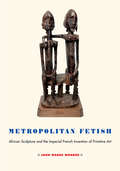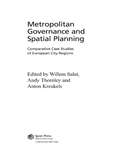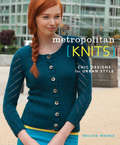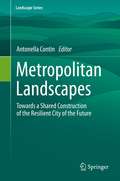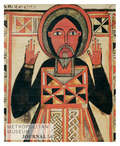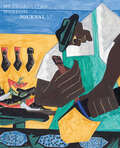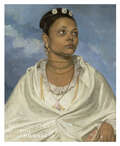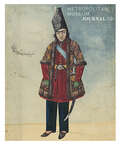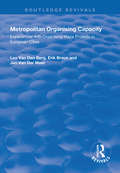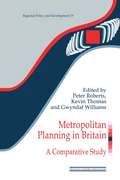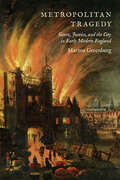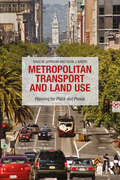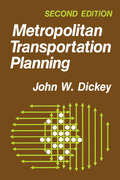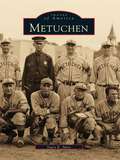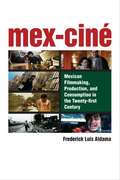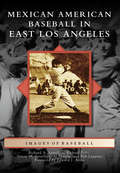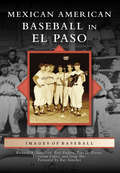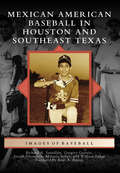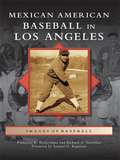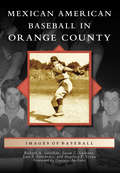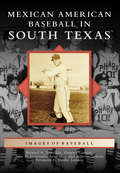- Table View
- List View
Metric Pattern Cutting for Menswear
by Winifred AldrichSince the first edition was published in 1980, Metric Pattern Cutting for Menswear has become established as the standard work on this subject and has proved invaluable as both a textbook for students and a reference source for the practising designer. In this fifth edition, the chapter on computer aided design now has full colour illustrations and reflects the growing importance of CAD to the industry and as a part of fashion and design courses. The rest of the book has been updated where necessary: in particular, new blocks for tailored shirts, new details on how to adapt men's blocks for women's wear, and a revision of sizing and labelling information. Colour is now used to differentiate the main groups of patterns and with its tried and tested layout with clear text and diagrams, Metric Pattern Cutting for Menswear is an essential purchase for students of fashion and design.
Metro Detroit Boxing (Images of Sports)
by Lindy LindellBoxing seemed to spring up in Detroit as early as 1900: heavyweight champ Jim Jeffries and future heavyweight champ Tommy Burns fought that year. With the emergence of Joe Louis in the 1930s and Thomas Mearns in the late 1970s, Motown enjoyed surges of interest in the sport. At the dawn of a new millenium, the presence of three casinos has given the sport another revival of interest in the city.Metro Detroit Boxing showcases over 180 photographs that reveal not only the personalities who have enlivened the sport in the Detroit area, but also the places in which boxers, trainers, managers, and promoters fought, trained, lived, worked, and recreated. Photographs include where Joe Louis went to school, trained, and fought. Various boxing celebrities, including Muhammad Ali, are caught for the camera, socializing with eminent politicians and other figures of the day.
Metro Detroit's High School Basketball Rivalries (Images of Sports)
by T. C. CameronFew cities can claim a hardwood heritage like that found in metro Detroit. Metro Detroit has been the epicenter for cataclysmic change in the past 60 years that no other major American city has suffered, but the one constant among so much upheaval is a passionate following afforded high school basketball. The rise and fall of the automotive industry, the Motown record label's emergence and eventual relocation, social and racial unrest, and the polarization of one of America's great cities has not slowed the love and passion Detroiters-city and suburban dwellers alike-share for prep basketball.
Metropolitan Art and Literature, 1810-1840
by Gregory DartGregory Dart expands upon existing notions of Cockneys and the 'Cockney School' in the late Romantic period by exploring some of the broader ramifications of the phenomenon in art and periodical literature. He argues that the term was not confined to discussion of the Leigh Hunt circle, but was fast becoming a way of gesturing towards everything in modern metropolitan life that seemed discrepant and disturbing. Covering the ground between Romanticism and Victorianism, Dart presents Cockneyism as a powerful critical currency in this period, which helps provide a link between the works of Leigh Hunt and Keats in the 1810s and the early works of Charles Dickens in the 1830s. Through an examination of literary history, art history, urban history and social history, this book identifies the early nineteenth century figure of the Cockney as the true ancestor of modernity.
Metropolitan Fetish: African Sculpture and the Imperial French Invention of Primitive Art
by John Warne MonroeFrom the 1880s to 1940, French colonial officials, businessmen and soldiers, returning from overseas postings, brought home wooden masks and figures from Africa. This imperial and cultural power-play is the jumping-off point for a story that travels from sub-Saharan Africa to Parisian art galleries; from the pages of fashion magazines, through the doors of the Louvre, to world fairs and international auction rooms; into the apartments of avant-garde critics and poets; to the streets of Harlem, and then full-circle back to colonial museums and schools in Dakar, Bamako, and Abidjan. John Warne Monroe guides us on this journey, one that goes far beyond the world of Picasso, Matisse, and Braque, to show how the Modernist avant-garde and the European colonial project influenced each other in profound and unexpected ways. Metropolitan Fetish reveals the complex trajectory of African material culture in the West and provides a map of that passage, tracing the interaction of cultural and imperial power. A broad and far-reaching history of the French reception of African art, it brings to life an era in which the aesthetic category of "primitive art" was invented.
Metropolitan Governance and Spatial Planning: Comparative Case Studies of European City-Regions
by Anton Kreukels Willem Salet Andy ThornleyMetropolitan Governance and Spatial Planning explores the relationship between metropolitan decision-making and strategies to co-ordinate spatial policy. This relationship is examined across 20 cities of Europe and the similarities and differences analysed.Cities are having to formulate their urban policies in a very complex and turbulent environment. They are faced with numerous new pressures and problems and these often create contradictory conditions. The book provides a theoretical framework for exploring these issues and links this to a detailed investigation of each city. In the context of globalisation, cities in the last twenty years have experienced new patterns of activity and these usually transcend political boundaries. The management of these changes therefore requires an effort of co-ordination and different cities have found different approaches.However the institutional setting itself has not remained static. The nation states in Europe have handed over many responsibilities to the European Union while also increasing devolution to regions and cities. Government has therefore become a more complex multi-level activity.There has also been the move from government to governance. Many different public, quasi-public and private bodies are now involved in making decisions that affect urban development. Metropolitan governance is therefore also a complex multi-actor process.In these conditions of fragmented governance and the widening spatial networking of urban development, the issue of policy co-ordination become ever more important. The exploration of the 20 cities shows that many face similar difficulties while some also provide interesting examples of innovative practice. The book concludes that the way forward is to find strategies to link the different spheres of metropolitan action through 'organising connectivity'.
Metropolitan Knits: Chic Designs for Urban Style
by Melissa WehrleBig city. Big style. Discover knitting that's fashionable yet timeless.Knit for uptown or downtown with a trend-setting New York City designer. With these 20 polished, sophisticated projects, knitwear designer Melissa Wehrle has created a collection that perfectly reflects the rhythm, flavor, and drama of city life.From a chunky cabled sweater and hat to a beautiful tunic and gossamer cardigan, Melissa's designs are beautifully shaped, expertly finished, and ready to be shown off on the street. They feature a variety of construction and finishing techniques, including knit-in pockets, tabs, button details, slip-stitch edgings, and small slits and pleats.Projects are divided along three themes:Heart of the City- Designed for those who enjoy sleek midtown in mind.Urban Bohemia- The downtown bohemian goddess will love these looks.City Gardens- Made to inspire a sense of tranquility.These three looks balance out a complete picture of the modern woman. What more could a city knitter need?
Metropolitan Landscapes: Towards a Shared Construction of the Resilient City of the Future (Landscape Series #28)
by Antonella ContinThis edited volume covers many aspects of the Metropolitan Landscapes. Solutions are needed to meet the demand of the citizens of a renewed metropolitan region landscape. It opens up discussions about possible toolkits for strategic actions based on understanding the territory from geographical, urban, architectural, economic, environmental, and public policy perspectives. This book intends to promote the Metropolitan dwelling quality, ensuring human well-being proposing a discussion on the resilient articulation of the interface space among the city's infrastructure, agriculture, and nature.This book results from the Symposium: Metropolitan Landscapes that MSLab of the Politecnico di Milano and ETSA (Sevilla) organized at the IALE 2019 Conference (Milan, July 2019) to manage radical territory transformation with a strategic vision. The widespread growth of urban areas indicates the importance of building resilient sustainable cities capable of minimizing climate-change impact production.The Symposium aimed to discuss the Urban Metabolism approach considering the combination of Landscapes set in a single Metropolitan Ecosystem. Accordingly, new design strategies of transformation, replacement or maintenance can compose Urban-Rural Linkage patterns and a decalage of different landscape contexts. Ecological interest in environmental sustainability, compatibility, and resilience is not tied exclusively to the balance between production and energy consumption. Thus, it is the integration over time and at several scales of the urban and rural landscapes and their inhabitants that nourish the Metropolitan Bioregion.Moreover, the Metropolitan Landscape Book's research hypothesis is the need for a Glossary, strengthening the basis of understanding Metropolitan Landscape's complexity.This book's topic is particularly relevant to Landscape Urbanism, Architecture, Urban disciplines Scholars, Students and Practitioners who want to be connected in a significant way with Metropolitan Discipline’s research field.
Metropolitan Museum Journal, volume 56 number 1 (January 2021)
by Metropolitan Museum JournalThis is volume 56 issue 1 of Metropolitan Museum Journal. Founded in 1968, the Metropolitan Museum Journal is a blind, peer-reviewed scholarly journal published annually that features original research on the history, interpretation, conservation, and scientific examination of works of art in the Museum’s collection. Its scope encompasses the diversity of artistic practice from antiquity to the present day. The Journal encourages contributions offering critical and innovative approaches that will further our understanding of works of art.
Metropolitan Museum Journal, volume 57 number 1 (January 2022)
by Metropolitan Museum JournalThis is volume 57 issue 1 of Metropolitan Museum Journal. Founded in 1968, the Metropolitan Museum Journal is a blind, peer-reviewed scholarly journal published annually that features original research on the history, interpretation, conservation, and scientific examination of works of art in the Museum’s collection. Its scope encompasses the diversity of artistic practice from antiquity to the present day. The Journal encourages contributions offering critical and innovative approaches that will further our understanding of works of art.
Metropolitan Museum Journal, volume 58 number 1 (January 2023)
by Metropolitan Museum JournalThis is volume 58 issue 1 of Metropolitan Museum Journal. Founded in 1968, the Metropolitan Museum Journal is a blind, peer-reviewed scholarly journal published annually that features original research on the history, interpretation, conservation, and scientific examination of works of art in the Museum’s collection. Its scope encompasses the diversity of artistic practice from antiquity to the present day. The Journal encourages contributions offering critical and innovative approaches that will further our understanding of works of art.
Metropolitan Museum Journal, volume 59 number 1 (January 2024)
by Metropolitan Museum JournalThis is volume 59 issue 1 of Metropolitan Museum Journal. Founded in 1968, the Metropolitan Museum Journal is a blind, peer-reviewed scholarly journal published annually that features original research on the history, interpretation, conservation, and scientific examination of works of art in the Museum’s collection. Its scope encompasses the diversity of artistic practice from antiquity to the present day. The Journal encourages contributions offering critical and innovative approaches that will further our understanding of works of art.
Metropolitan Organising Capacity: Experiences with Organising Major Projects in European Cities (Routledge Revivals)
by Erik Braun Leo van Berg Jan van MeerPublished in 1997. The environment of cities has become increasingly competitive. Tradition location factors, that once tied economic activities firmly to particular areas have become less important. Increasingly the ability of a city to anticipate, respond to and cope with internal and external changes is getting attention. Organizing capacity of cities, or of metropolitan regions is becoming indispensible for sustainable economic and social development. The authors have carried out investigations into eight European cities to increase the insight into the practice of organizing capacity. The analysis of the development and implementation of 15 revitalization projects in these cities shows that organizing capacity calls for a new style of entrepreneurial urban management with public and private networking, leadership, long term strategies and organizing political and public support as key concepts.
Metropolitan Planning in Britain: A Comparative Study (Regions and Cities #19)
by Peter Roberts Kevin Thomas Gwyndaf WilliamsMetropolitan Planning in Britain is the first comparative analysis and assessment of metropolitan areas and their strategic planning for almost two decades. Changes in population distribution, styles of local government, business practices, and attitudes to the environment have all had an impact on cities in recent years which planners and other policy makers must take into consideration. Based on a series of research projects and the activities of a study group supported by the Regional Studies Association, the book examines in detail nine major urban areas, their specific characters and requirements, and how metropolitan planning is adapting to fulfil those requirements. It also discuses the possible future evolution of metropolitan planning, especially in the light of new regional arrangements and devolution.
Metropolitan Tragedy
by Marissa GreenbergBreaking new ground in the study of tragedy, early modern theatre, and literary London, Metropolitan Tragedy demonstrates that early modern tragedy emerged from the juncture of radical changes in London's urban fabric and the city's judicial procedures. Marissa Greenberg argues that plays by Shakespeare, Milton, Massinger, and others rework classical conventions to represent the city as a locus of suffering and loss while they reflect on actual sources of injustice in sixteenth- and seventeenth-century London: structural upheaval, imperial ambition, and political tyranny.Drawing on a rich archive of printed and manuscript sources, including numerous images of England's capital, Greenberg reveals the competing ideas about the metropolis that mediated responses to theatrical tragedy. The first study of early modern tragedy as an urban genre, Metropolitan Tragedy advances our understanding of the intersections between genre and history.
Metropolitan Transport and Land Use: Planning for Place and Plexus
by David M Levinson Kevin J KrizekAs cities around the globe respond to rapid technological changes and political pressures, coordinated transport and land use planning is an often targeted aim. Metropolitan Transport and Land Use, the second edition of Planning for Place and Plexus, provides unique and updated perspectives on metropolitan transport networks and land use planning, challenging current planning strategies, offering frameworks to understand and evaluate policy, and suggesting alternative solutions. The book includes current and cutting-edge theory, findings, and recommendations which are cleverly illustrated throughout using international examples. This revised work continues to serve as a valuable resource for students, researchers, practitioners, and policy advisors working across transport, land use, and planning.
Metropolitan Transportation Planning (2nd Edition)
by John W. DickeyMetropolitan Transportation Planning (2nd Edition) by John W. Dickey.
Metuchen
by Stacy E. SpiesLocated in central New Jersey's Middlesex County,Metuchen was historically known for the stellarcollection of literary, artistic, and industrial talent who resided here, and earned the nickname the "Brainy Boro." Since its beginnings as a village within Raritan township, Metuchen has matured from its roots as a commercial center for area farmers into a desirable suburban community. Metuchen compiles photographs from the rich collections of the Metuchen-Edison Historical Society, including some of the hundreds of photographs taken in the early years of the twentieth century by resident J. Lloyd Grimstead. The pages of Metuchen invite you to shop the businesses along Main Street, wait for the morning train with the commuters, and tour the gracious homes along Graham and Lake Avenues. In sharp, illustrative detail, you can visit historicBorough Hall and the library, and meet or reacquaintyourself with some of the people who made Metuchentheir home.
Mex-Ciné: Mexican Filmmaking, Production, and Consumption in the Twenty-first Century
by Aldama Frederick LuisMex-Ciné offers an accessibly written, multidisciplinary investigation of contemporary Mexican cinema that combines industrial, technical, and sociopolitical analysis with analyses of modes of reception through cognitive theory. Mex-Ciné aims to make visible the twenty-first century Mexican film industry, its blueprints, and the cognitive and emotive faculties involved in making and consuming its corpus. A sustained, free-flowing book-length meditation, Mex-Ciné enriches our understanding of the way contemporary Mexican directors use specific technical devices, structures, and characterizations in making films in ways that guide the perceptual, emotive, and cognitive faculties of their ideal audiences, while providing the historical contexts in which these films are made and consumed.
Mexican American Baseball in East Los Angeles (Images of Baseball)
by Richard A. Santillán Al Padilla Bob Lagunas Richard Peña Teresa M. SantillánMexican American Baseball in East Los Angeles highlights the unforgettable teams, players, and coaches who graced the hallowed fields of East Los Angeles between 1917 and 2016 and brought immense joy and honor to their neighborhoods. Off the field, these players and their families helped create the multibillion-dollar wealth that depended on their backbreaking labor. More than a game, baseball and softball were political instruments designed to promote and empower civil, political, cultural, and gender rights, confronting head-on the reactionary forces of prejudice, intolerance, sexism, and xenophobia. A century later, baseball and softball are more popular than ever in East Los Angeles. Dedicated coaches still produce gifted players and future community leaders. These breathtaking photographs and heartfelt stories shed unparalleled light to the long and rich history of baseball and softball in the largest Mexican American community in the United States.
Mexican American Baseball in El Paso (Images of Baseball)
by Richard A. Santillan Donavan Lopez Eric Enders Pete G. FloresMexican American Baseball in El Paso chronicles the vibrant and colorful history of baseball in the El Paso–Juárez border region. For more than a century, baseball along the border has served as a means of bringing together people of all backgrounds, races, and nationalities, from the fly-by-night teams of the Pancho Villa era to the fabled semiprofessional clubs of the Lower Valley League. For the area’s Mexican and Mexican American citizens, storied teams like the Juárez Indios, Fabens Merchants, 1949 Bowie Bears, and El Paso Diablos served as both community rallying points and signposts of cultural identity. From the legendary semiprofessional players of decades past to the most recent major leaguers, this book presents the photographic history of baseball in America’s largest border community.
Mexican American Baseball in Houston and Southeast Texas (Images of Baseball)
by Richard A. Santillán Gregory Garrett Ramos Joseph Thompson Mikaela Selley William LangeMexican American Baseball in Houston and Southeast Texas pays tribute to the baseball and softball players and teams from Houston, Sugar Land, Texas City, Richmond, and other surrounding communities in the region. Since the early 1900s, this game has had an important role in the lives of area Mexican Americans. In the Houston barrios, when entrenched discriminatory practices obstructed city unity, the diamond brought people together. In the Sugar Land region, Mexican Americans, African Americans, and Anglos worked and played together, blurring racial lines. Baseball and softball built community pride and connected generations of Mexican American families. The wonderful stories and breathtaking images in this book help resurrect the rich and little-known history of Mexican American baseball and softball in this key part of Texas.
Mexican American Baseball in Los Angeles (Images of Baseball)
by Francisco E. Balderrama Samuel O. Regalado Richard A. SantillanImages of Baseball: Mexican American Baseball in Los Angeles celebrates the flourishing culture of the great pastime in East Los Angeles and other communities where a strong sense of Mexican identity and pride was fostered in a sporting atmosphere of both fierce athleticism and social celebration. From 1900, with the establishment of the Mexican immigrant community, to the rise of Fernandomania in the 1980s, baseball diamonds in greater Los Angeles were both proving grounds for youth as they entered their educations and careers, and the foundation for the talented Forty-Sixty Club, comprised of players of at least 40, and often over 60, years of age. These evocative photographs look back on the great Mexican American teams and players of the 20th century, including the famous Chorizeros--the proclaimed "Yankees of East L.A."
Mexican American Baseball in Orange County (Images of Baseball)
by Gustavo Arellano Richard A. Santillan Angelina F. Veyna Luis F. Fernandez Susan C. LuévanoImages of Baseball: Mexican American Baseball in Orange County celebrates the once-vibrant culture of baseball and softball teams from Placentia, Anaheim, Santa Ana, Westminster, San Juan Capistrano, and nearby towns. Baseball allowed men and women to showcase their athletic and leadership skills, engaged family members, and enabled community members to develop social and political networks. Players from the barrios and colonias of La Fábrica, Campo Colorado, La Jolla, Logan, Cypress Street, El Modena, and La Colonia Independencia, among others, affirmed their Mexican and American identities through their sport. Such legendary teams as the Placentia Merchants, the Juveniles of La Habra, the Lionettes de Orange, the Toreros of Westminster, and the Road Kings of Colonia 17th made weekends memorable. Players and their families helped create the economic backbone and wealth evident in Orange County today. This book sheds light on powerful images and stories of the Mexican American community.
Mexican American Baseball in South Texas (Images of Baseball)
by Richard A. Santillán Gregory Garrett Jorge Iber Juan D. Coronado Roberto ZamoraMexican American Baseball in South Texas pays tribute to the former baseball teams and players from Edinburg, McAllen, Mission, Pharr, Donna, Alamo, San Juan, Brownsville, Harlingen, and other surrounding communities. From the late 19th century through the 1950s, baseball in South Texas provided opportunities for nurturing athletic and educational skills, reaffirming ethnic identity, promoting political self-determination, developing economic autonomy, and reshaping gender roles for women. Games were special times where Mexican Americans found refuge from backbreaking work and prejudice. These unmatched photographs and stories shed light on the rich history of baseball in this region of Texas.
